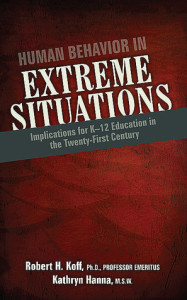★★★½ 
Human Behavior in Extreme Situations by Robert H. Koff and Kathryn R. Hanna is a book that unfortunately needed to be written, given that school shootings have become the “new normal.” Investigating a number of tragic events throughout history, Koff and Hanna examine what we can learn from them in order to be better prepared when a similar events happen in the future.
Koff and Hanna make clear at the outset that this book isn’t about preventative methods. They don’t delve into the gun control/mental health debate. They reference the head of the NRA saying “We need to be prepared” only to illustrate that preparation is key, not that arming teachers is the answer. Mostly, the book focuses on how people have dealt with crisis situations in the past, and how these traits can potentially aid in planning for a school tragedy.
Unfortunately, the book doesn’t entirely make good on its premise. Though the book begins with talking about school shootings and how we need methods to adapt to these seemingly-inevitable tragedies, much of the book doesn’t address how to react to just this sort of situation. For example, there is a chapter about Shackleton, whose ship Endurance wrecked in the freezing Weddell Sea, stranding its crew in ice packs for over a year before an heroic attempt planned over their 10-month incarceration by the captain saw them saved. As courageous as they certainly were, this case has very little to do with a school shooting, in which people need to make split-second decisions.
In other examples, there’s discussion about prison uprisings in Auschwitz and Japan, where the conclusion is it’s important to have a plan ahead of time. In short, many of these crisis situations are not comparable and so aren’t entirely instructive. As the subheading is “Implications for K–12 Education in the Twenty-First Century,” the examples needed to be more applicable to today’s violent climate. In a book about human behavior during a shooting rampage, there isn’t one chapter about how people have survived a school shooting.
Koff and Hanna do acknowledge this somewhat in the second section. They write: “In an emergency situation, there is often no time to rally a group together, but having a clear idea of who the leader in a given situation is could mean the difference between life and death.” The main prescription of “leadership” seems fairly unhelpful in the face of an armed shooter, especially when measured against tragedies that took many months to unfold. Given that there are examples of teachers helping students during such a crisis, this should have been more of a focus.
The book is much better when it talks about the aftermath of a tragic event, and how to best organize, so there is more to be gleaned from this section. The chapters about other tragedies are informative as well, even if not entirely relevant. Finally, the surveys in the appendix for students, parents, and school officials are very well done, asking a number of pertinent questions about how people can be prepared. Perhaps the book would have been better served being front-loaded with this sort of information, rather than weighting the book so heavily on non-applicable examples.
Overall, the book is a laudable attempt at exploring and understanding this tragic issue, but does not delve into the subject deeply enough, and so doesn’t offer many concrete answers. As a starting point there’s a fair amount that will spur discussion, which in itself is an important part of preparation. Because these incidents are becoming more and more frequent, any amount of extra preparation is vital.
Links
Inkwater Books
Amazon
Goodreads
Review Overview
Design
Editing
Content
Get an Editorial Review | Get Amazon Sales & Reviews | Get Edited | Publish Your Book | Enter the SPR Book Awards | Other Marketing Services























Leave A Comment